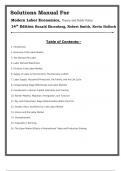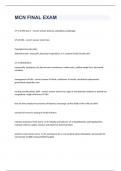Modern Labor Economics, Theory and Public Policy
14th Edition Ronald Ehrenberg, Robert Smith, Kevin Hallock
Table of Contents:-
1. Introduction
2. Overview of the Labor Market
3. The Demand for Labor
4. Labor Demand Elasticities
5. Frictions in the Labor Market
6. Supply of Labor to the Economy: The Decision to Work
7. Labor Supply: Household Production, the Family, and the Life Cycle
8. Compensating Wage Differentials and Labor Markets
9. Investments in Human Capital: Education and Training
10. Worker Mobility: Migration, Immigration, and Turnover
11. Pay and Productivity: Wage Determination Within the Firm
12. Gender, Race, and Ethnicity in the Labor Market
13. Unions and the Labor Market
14. Unemployment
15. Inequality in Earnings
16. The Labor Market Effects of International Trade and Production Sharing
,Chapter No 01: Introduction
Because the textbook stresses economic analysis as it applies to the labor market, students
must understand the ways economic analyses are used. The basic purpose of Chapter 1 is
to introduce students to the two major modes of economic analysis: positive and
normative.
Because both modes of analysis rest on some very fundamental assumptions, Chapter 1
discusses the bases of each mode in some detail.
In our treatment of positive economics, the concept of rationality is defined and
discussed, as is the underlying concept of scarcity. There is, in addition, a lengthy
discussion of what an economic model is, and an example of the behavioral predictions
flowing from such a model is presented. The discussion of normative economics
emphasizes its philosophical underpinnings and includes a discussion of the conditions
under which a market would fail to produce results consistent with the normative
criteria. Labor market examples of governmental remedies are provided.
The appendix to Chapter 1 introduces the student to ordinary least squares regression
analysis. It begins with univariate analysis, introduced in a graphical context, explaining
the concepts of dependent and independent variables, the "intercept" and "slope"
parameters, the "error term," and the t statistic. The analysis then moves to multivariate
analysis and the problem of omitted variables.
List of Major Concepts
1. The essential features of a market include the facilitation of contact between
buyers and sellers, the exchange of information, and the execution of contracts.
2. The uniqueness of labor services affects the characteristics of the labor market.
3. Positive economics is the study of economic behavior, and underlying this
theory of behavior are the basic assumptions of scarcity and rationality.
4. Normative economics is the study of what "should be," and theories of social
optimality are based in part on the underlying philosophical principle of "mutual
benefit. "
5. A market "fails" when it does not permit all mutually beneficial trades to take
place, and there are three common reasons for such failure.
6. A governmental policy is "Pareto-improving" if it encourages additional mutually
beneficial transactions. At times, though, the goal of improving Pareto efficiency
conflicts with one of generating more equity.
1
,7. The concept that governmental intervention in a market may be justified on grounds
other than the principle of mutual benefit is discussed (for example, government
intervention may be justified on the grounds that income redistribution is a desirable
social objective).
8. (Appendix) The relationship between two economic variables (e.g., wages and quit
rates) can be plotted graphically; this visual relationship can also be summarized
algebraically.
9. (Appendix) A way to summarize a linear relationship between two variables is
through ordinary least squares regression analysis -- a procedure that plots the "best"
line (the one that minimizes the sum of squared deviations) through the various data
points. The parameters describing this line are estimated, and the uncertainty
surrounding these estimates are summarized by the standard error of the estimate.
10. (Appendix) Multivariate procedures for summarizing the relationship between a
dependent and two or more independent variables is a generalization of the
univariate procedure, and each coefficient can be interpreted as the effect on the
dependent variable of a one-unit change in the relevant independent variable, holding
the other variables constant.
11. (Appendix) If an independent variable that should be in an estimating equation is
left out, estimates of the other coefficients may be biased away from their true
values.
Answers to Even-Numbered Review Questions
2. Are the following statements "positive" or "normative"? Why?
a. Employers should not be required to offer pensions to their employees.
b. Employers offering pension benefits will pay lower wages than they would if
they did not offer a pension program.
c. If further immigration of unskilled foreigners is prevented, the wages of
unskilled immigrants already here will rise.
d. The military draft compels people to engage in a transaction they would
not voluntarily enter into; it should therefore be avoided as a way of
recruiting military personnel.
e. If the military draft were reinstituted, military salaries would
probably fall. Answer: (a) normative (b) positive (c) positive (d) normative (e)
positive
4. What are the functions and limitations of an economic model?
Answer: The major function of an economic model is to strip away real world complexities
2
, and focus on a particular cause/effect relationship. In this sense an economic model is
analogous to an architect's model of a building. An architect may be interested in
designing a building that fits in harmoniously with its surroundings, and in designing such
a building, the architect may employ a model that captures the essentials of his or her
concerns (namely, appearance) without getting into the complexities of plumbing,
electrical circuits, and the design of interior office space. Similarly, an economic model will
often focus on a particular kind of behavior and ignore complexities that are either not
germane to that behavior or only of indirect importance.
Models used to generate insights about responses to a given economic stimulus are often
not intended to forecast actual outcomes. For example, if we are interested in bow
behavior is affected by stimulus B, with factors C, D, and E held constant, our model may
not correctly forecast the observed behavior if stimuli C through E also change.
6. A law in one town of a Canadian province limits large supermarkets to just four employees on
Sundays. Analyze this law using the concepts of normative economics.
Answer: Laws restricting employment essentially block mutually beneficial transactions.
There are employees who want to work on Sundays, and there were employers who
wanted to employ them on Sundays. The restrictions upon their employment prevented
these transactions from occurring and therefore made both workers and their potential
employers worse off. Thus from a positive point of view, this is not optimal. However,
some may feel that fewer people should work on Sunday, and thus from a normative
point of view, some may find it acceptable.
8. In discussing ways to reduce lung diseases caused by workplace hazards, one commentator said:
“Gas masks are very uncomfortable to wear, but economists would argue that they are the
socially preferred method for reducing the inhalation of toxic substances whenever they can be
produced for less than it takes to alter a ventilation system.”
Comment on this quotation from the perspective of normative economics.
Answer: This commentator considers only the costs of production, and not any additional benefits
from the ease of working without gas masks, so in fact it may be that this is not optimal from either
a positive or normative view. From a normative point of view, some may feel that workers should
not be compelled to wear uncomfortable gas masks, and thus it may be desirable to require
ventilation systems rather than allowing the option of masks.
Answers to Even-Numbered Problems
2. (Appendix) Suppose that a least squares regression yields the following estimate: Wi
= -1 + .3Ai, where W is the hourly wage rate (in dollars) and A is the age in years. A
second regression from another group of workers yields this estimate:
Wi = 3 + .3Ai - .01(Ai)2.
a. How much is a 20-year-old predicted to earn based on the first estimate?
3





